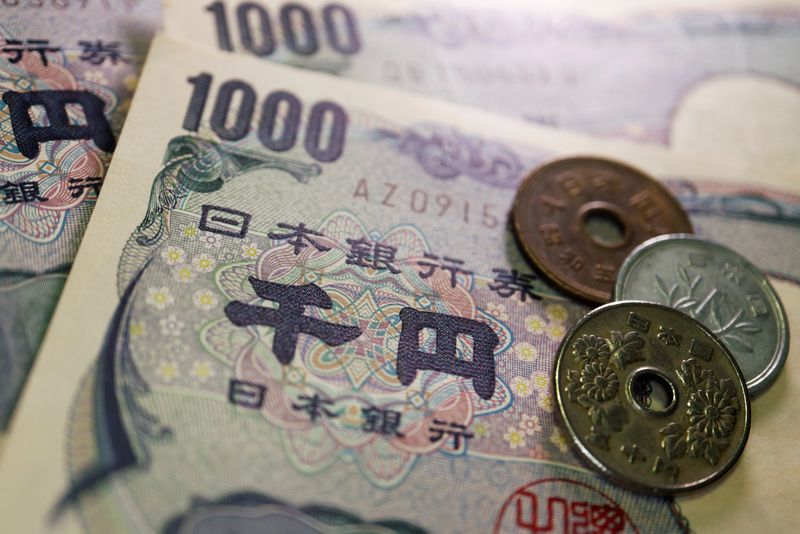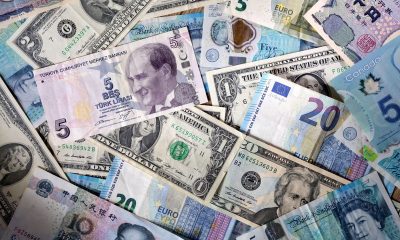Forex
Analysis – Politics, Fed seen swaying Japan’s yen intervention thinking


© Reuters. FILE PHOTO: Coins and banknotes of Japanese yen are seen in this illustration picture taken June 16, 2022. REUTERS/Florence Lo/Illustration
By Leika Kihara and Tetsushi Kajimoto
TOKYO (Reuters) – The Federal Reserve’s Jackson Hole symposium this week looms as a key risk for Japanese authorities worried that new hawkish signals from U.S. central bankers could trigger another sharp yen selloff that would force Tokyo to prop up the currency.
The annual gathering of Fed officials and other global policymakers has historically been an opportunity for central bankers to regroup and flag their next big steps to markets.
Until recently, investors had expected Fed Chair Jerome Powell might be looking to end to interest rate hikes amid signs inflation was moderating.
The worry now for Japanese officials is that he signals the opposite as price pressures linger, which could trigger a repeat of last year’s yen selloff against the dollar, forcing authorities to intervene again.
While the yen’s fortunes are largely a product of dollar movements, the currency’s weakness has become politically problematic not only for Prime Minister Fumio Kishida but also the Bank of Japan, whose ultra-loose monetary settings have been blamed for inflating import costs.
“Authorities aren’t worried about the weak yen as much as they were around September and October last year,” said Masafumi Yamamoto, chief currency strategist at Mizuho Securities.
“But the chance of intervention will heighten if a worsening economy hurts the administration’s approval ratings.”
Money markets expect the Fed to maintain rates in the current 5.25%-5.5% range until the second quarter next year before starting to ease. But investors will be looking for clues about possible additional rate hikes from Powell’s speech on Friday.
BOJ Governor Kazuo Ueda is scheduled to attend the Jackson Hole meeting, which has thrown Japan curve balls in the past.
In 2010, former Fed Chair Ben Bernanke’s suggestion of deploying quantitative easing triggered a yen spike that forced then BOJ head Masaaki Shirakawa to cut short his stay at the retreat, and call an emergency meeting in Tokyo to ease monetary policy.
This time around, concerns centre on yen weakness.
To be sure, Japan has not been as worried by recent bouts of yen selling, issuing fewer verbal warnings even as the dollar breached the 145 mark that triggered intervention last year.
With the pace of yen declines moderate and a revival of inbound tourism turning the public’s attention to the benefits of a weak currency, authorities see the threshold for yen-buying currency intervention fairly high compared with last year.
But the more passive approach could change if hawkish comments by Powell drive up the dollar/yen at a faster speed, say three government officials with direct knowledge on Japan’s currency policy.
“Japan likely won’t intervene as long as the moves are gradual,” one of the officials said. “It’s really about cracking down on speed limit violations.”
The yen lost about 1.5% against the dollar this month, much slower than a 4.8% dive seen in the three weeks to Oct. 21 last year when the dollar hit a 32-year high above 150 yen.
POLITICS OF 150
While authorities say that speed – rather than levels – is key in deciding when to step in, a breach of the 150 yen threshold could heighten political pressure on Prime Minister Kishida to act, the officials say.
With his approval ratings sliding, Kishida on Tuesday unveiled a plan to cushion the blow from rising fuel costs driven in part by the weak yen.
“When to intervene has always been an extremely political decision in Japan. Nowadays, it’s the prime minister that ultimately makes the call,” said Atsushi Takeuchi, a former BOJ official who was involved in Tokyo’s market foray a decade ago.
“Authorities usually don’t have a specific line-in-the-sand in mind. But key thresholds like 150 are important for political reasons, as they are easy to understand.”
Japan’s dilemma runs deep. Core inflation exceeded the central bank’s 2% target for 16 straight months in July as firms continue to pass on higher import costs driven in part by the weak yen.
Worried about hurting a fragile economy, the BOJ has stressed its resolve to keep interest rates ultra-low even as it decided last month to raise a cap on long-term bond yields.
The BOJ’s dovish tone, coupled with prospects that U.S. interest rates could stay higher for longer, has kept the dollar hovering around a nine-month high of 146.565 yen hit last week.
But while the Fed and worries about China’s economic woes could bring yen moves back into focus, there are doubts intervention would actually achieve much.
“Authorities could smooth the pace of currency moves,” said Daisaku Ueno, chief currency strategist at Mitsubishi UFJ (NYSE:) Morgan Stanley Securities. “But they can’t affect levels or trend, which depends largely on U.S. monetary policy.”

 Forex3 years ago
Forex3 years agoForex Today: the dollar is gaining strength amid gloomy sentiment at the start of the Fed’s week

 Forex3 years ago
Forex3 years agoUnbiased review of Pocket Option broker

 Forex3 years ago
Forex3 years agoDollar to pound sterling exchange rate today: Pound plummeted to its lowest since 1985

 Forex3 years ago
Forex3 years agoHow is the Australian dollar doing today?

 Cryptocurrency3 years ago
Cryptocurrency3 years agoWhat happened in the crypto market – current events today

 World3 years ago
World3 years agoWhy are modern video games an art form?

 Commodities3 years ago
Commodities3 years agoCopper continues to fall in price on expectations of lower demand in China

 Economy3 years ago
Economy3 years agoCrude oil tankers double in price due to EU anti-Russian sanctions


























